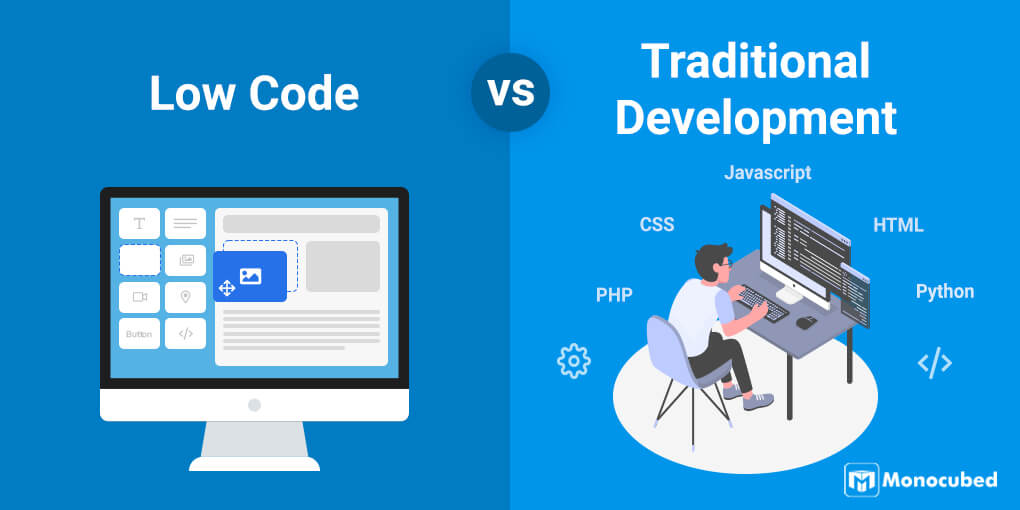Handy Suggestions To Picking Legacy application modernization with Low-code
Wiki Article
The Accessibility Of Low-Code Applications Is Among The Major Advantages.
Low-code application development significantly improves accessibility for non-developers. They are often referred to as "citizen developers" because of several important aspects: Intuitive visual interfaces:
Drag-and-Drop Builders: Low-code platforms come with drag-and-drop interfaces, which allow non-developers create applications without having to write a single line of code. This lets development be easier for people with backgrounds in technology.
WYSIWYG Editors - "What You Seen Is What You Get" editors assist users in creating workflows or interfaces that look like the final products, making them more understandable.
Simple Workflow and Logic Design:
Visual Workflow Modeling: Users may design business processes and application logic by using visual flowcharts or models, which are more user-friendly than traditional coding methods.
Low-code platforms typically have pre-built logic elements (e.g. statements that are conditional, loops) that can be easily set up, reducing the need for complex coding.
Reusable Components and Templates
Libraries of prebuilt templates Low-code platforms often offer templates from libraries for various types of application. This allows non-developers the possibility of starting with a solid foundation and then modify it according to their needs.
Reusable Widgets and Modules Users can leverage reused widgets and modules to streamline the process of creating them and reducing the requirement for technical knowledge.
Guided Development and Tutorials
Step-by-Step Guides: Platforms typically provide a development path with guidance, online tutorials, or on-screen directions to help users who aren't developers to create applications.
Interactive Tutorials Interactive, hands-on tutorials allow users to learn through doing, improving their understanding and confidence in using the platform.
Integration with existing tools
Seamless Integration: Low-code platforms are designed to seamlessly integrate with the tools and systems within business (e.g. the ERP or CRM) that allows non-developers, to create applications that can work within existing workflows.
APIs Connectors: APIs are built into applications to simplify integration. This allows non-programmers who do not have coding skills, to connect with external services.
Collaboration Features:
Team Collaboration: real-time collaboration, shared workspaces and shared workspaces enable business analysts, non-developers, and other stakeholders to effectively work alongside professional developers.
Access levels are able to be set for people who aren't developers to make sure they are able to contribute to the development process, but without compromising security.
Automated Testing & Debugging
Low-code platforms include tools for testing and debugging that are built in. They automate this process so it is easy for non-developers to ensure that their apps function.
Platform highlights errors when they occur and offers fixes. This assists non-developers in solving problems.
Overall, the main advantage of developing low-code applications for accessibility to non-developers comes in its ability to democratize the development process. Platforms with low-code enable business users by offering them intuitive, visual and guided tools. They are then able to actively participate in developing and maintaining applications. Check out the most popular Low-code Platform for application development hints for more examples including no code platforms, application modernisation, cross platform app development, application modernisation, rad development, develop web app, rapid application design, develop web app, develop web app, application modernisation and more.

Benefits Of Low-Code Application Development For Governance And Security
Low-code development has several benefits regarding security and governance. These are crucial to ensure that apps are secure, compliant and properly managed throughout their lifecycle. Here are a few of the main advantages.
Unified Manage Console: Lowcode platforms usually have a management console which allows administrators to manage and supervise applications.
Role-Based Access Control: These platforms include robust role-based control that lets administrators define guidelines and enforce them. This allows only authorized users to alter or access specific elements of a program.
The Compliance Process and Regulatory Adherence:
Conformity features: A lot of platforms that make use of low-code are designed to be in line with industry standards. They offer frameworks and instruments that ensure applications meet the requirements.
Audit Trails: Organizations often integrate comprehensive logging and audit trail systems, which enable them to monitor changes as well as track access, and ensure compliance with both internal and external regulations.
Additional Security Measures
Data Encryption Low-code platforms often come with built-in encryption of information in transit and in rest, securing sensitive data.
Security Certificates: Many low-code companies have a security certificate (e.g. ISO 27001 and SOC 2) which demonstrate that they are adhering to strict security guidelines. They also provide an extra security level to their customers.
Automatic security updates for security:
Regular patching and updates Low-code platforms manage the majority of security patches and updates automatically. They ensure that applications are secure from the latest attacks without requiring developers to intervene manually.
Security Monitoring - Continuous security monitoring is usually included. It provides real-time insight and alerts about possible security threats.
Data Governance
Data Access Policy: These platforms help organizations define and enforce policies regarding data access, ensuring sure that only authorized individuals have access to data and that the data is utilized in a safe manner.
Data Masking and anonymization: The built-in tools for masking data and anonymization help protect sensitive information, especially in the testing and development environment.
Consistent Lifecycle Management of Applications
Pipelines for development and deployment Low-code platforms provide integrated development and deploy pipelines which include security inspections. These ensure that security is maintained through the entire application lifecycle.
Version Control - The integrated version control helps monitor changes to applications and allows them to be reverted when needed. They also ensure the integrity and quality of the application.
User Authentication, Authorization, and Authorization
Single Sign-On (SSO) Support for single sign-on and other advanced authentication methods makes managing users easier and increases security.
Multi-Factor Authentication – Many platforms have built-in functions for multi-factor authentication, providing an additional layer for security.
Compliance Monitoring and Policy Enforcement Compliance Monitoring:
Low-code platforms come with policies that are predefined to help organizations implement security and governance policies as well as governance policies.
Compliance Monitoring Tools: They give continuous monitoring and a report on compliance status. This helps to spot potential problems and address them proactively.
Integration into Existing Security Infrastructure
Seamless Integration: Low-code platforms are designed to work seamlessly with existing security infrastructure and tools, including identity management solutions, SIEMs (Security Information and Event Management Solutions), and firewalls.
API Security: Built in API security features help protect the data of API users, ensure integrity of applications and secure integrations.
Best Practices and Training
Best practices: Many platforms have guidelines for developing secure apps, as well as the best practices. This assists non-developers to adhere to security standards.
Some low-code vendors offer security training that helps users learn how to develop and maintain secure apps.
Low-code development can provide a range of security and governance benefits that ensure applications are developed and managed in an efficient way, safe and in compliance. These platforms provide all the tools and frameworks required to safeguard sensitive data and enforce policies, while ensuring regulatory compliance. Take a look at the most popular Legacy application modernization with Low-code url for website info including rapid app development, cloud software applications, rapid applications, low code platforms, cloud software applications, low code development platforms, low code platforms, app modernization, cross platform mobile dev, develop mobile application and more.

Benefits Of Low-Code Application Development In Terms Of Collaboration And Workflow
Low-code application development is a good choice for businesses who want to boost team productivity by streamlining development processes. Here are the major benefits: Improved Collaboration Across Functions:
Unified Development Environment. Low-code platforms enable all team members to work together in one unified environment. This includes developers, business analyst and designers as well as stakeholder. This helps eliminate silos and encourages better communication.
Visual Development: The low-code platform's visual drag-anddrop capabilities make it easy for nontechnical team participants to contribute in the process of design. It also makes sure that business needs are properly documented and then implemented.
Communication Enhanced
Real-Time Collaboration Many low-code applications include real-time features, such as commenting and editing simultaneously, or immediate feedback. This enables constant communication and can help decrease the amount of time wasted on back-and-forth discussions.
Workspaces shared by teams have the ability to work together in shared workspaces, in which they edit and discuss the project's elements. This ensures that everyone is working towards the same goals and is on the exact same level.
A streamlined workflow management system:
Integrated Project Management Tools: Many low-code platforms come with integrated tools for project management which can assist teams to track and manage their development projects. This includes tasks management, progress tracking and management of deadlines.
Workflow Automation: Automating routine tasks and workflows decreases errors and manual labor which allows teams to concentrate on more strategic work and enhancing overall efficiency.
Speedier Iteration:
Rapid Prototyping: Low-code platforms allow rapid prototyping and iterative development, allowing teams to develop prototypes, test, and refine applications over shorter periods of time. This allows feedback to be incorporated quickly into the application, and for rapid enhancements.
Support for Agile Development: Using agile practices lets teams be continuously working in sprints. This makes it simpler to adapt and deliver small incremental improvements to functionalities.
Accessibility for non-Developers
Citizen Development: Low-code platforms allow users in the business (citizen developers) to develop and modify applications without extensive coding knowledge. This allows IT and development teams to focus on other tasks and be more responsive to business requirements.
Onboarding and training: The intuitive user interfaces as well as a wealth of training materials help bring new team members up to level. This helps improve overall collaboration in the team.
Centralized documentation, knowledge sharing and dissemination:
Integrated Documentation: Low-code systems typically include tools for creating and maintaining documentation within the platform itself and ensuring that all information about projects is centralized and easily accessible.
Knowledge Repositories. Teams can establish repository of knowledge, with templates and parts that can be reused. This can facilitate knowledge sharing, and reduce duplication.
Standardization and Consistency:
Standardized Components - The use of already-built, standardized components gives an enduring consistency across the different applications. It makes it easier for team members to grasp the different components of a given project and work on these components.
Governance and compliance: Integrated governance frameworks help ensure that development is in line with regulations and standards of the organization. This decreases the chance of non-compliance, as well as helping applications meet quality standards.
Feedback Loops and Improvement Loops
Integrated Feedback: Low-code platforms provide users with integrated feedback mechanisms that enable them to provide feedback easily on applications. The feedback is used in the development process.
Continuous Improvement: The capability to rapidly iterate deployment, change and deploy applications in response to user feedback allows them to be aligned with business goals and user requirements.
Visualization of Reporting:
Real-time Analytics: In-built analytics and reports provide real-time information about the performance of your project, user interactions and the progress. Data-driven decision-making is feasible.
Visual Workflow Analysis: Visual tools are used to visualize workflows and processes. These tools help teams determine and improve their workflows.
When it comes to collaboration, low-code software is ideal for reducing workflows, bring teams from different backgrounds together and streamline tasks. This promotes a more agile productive, collaborative and efficient setting for development. This ultimately results in better-quality applications as well as better alignment of goals for business.
